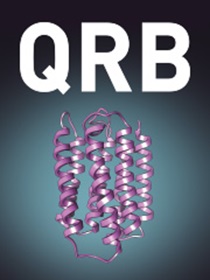Frontier methods in coherent X-ray diffraction for high-resolution structure determination
IF 7.2
2区 生物学
Q1 BIOPHYSICS
引用次数: 11
Abstract
Abstract In 1912, Max von Laue and collaborators first observed diffraction spots from a millimeter-sized crystal of copper sulfate using an X-ray tube. Crystallography was born of this experiment, and since then, diffraction by both X-rays and electrons has revealed a myriad of inorganic and organic structures, including structures of complex protein assemblies. Advancements in X-ray sources have spurred a revolution in structure determination, facilitated by the development of new methods. This review explores some of the frontier methods that are shaping the future of X-ray diffraction, including coherent diffractive imaging, serial femtosecond X-ray crystallography and small-angle X-ray scattering. Collectively, these methods expand the current limits of structure determination in biological systems across multiple length and time scales.相干x射线衍射高分辨率结构测定的前沿方法
1912年,马克斯·冯·劳厄及其合作者首次使用x射线管从一毫米大小的硫酸铜晶体上观察到衍射斑点。晶体学由此诞生,从那时起,x射线和电子衍射揭示了无数的无机和有机结构,包括复杂蛋白质组合的结构。x射线源的进步刺激了结构测定的革命,促进了新方法的发展。本文综述了影响x射线衍射未来的一些前沿方法,包括相干衍射成像、连续飞秒x射线晶体学和小角度x射线散射。总的来说,这些方法在多个长度和时间尺度上扩展了生物系统中结构确定的当前限制。
本文章由计算机程序翻译,如有差异,请以英文原文为准。
求助全文
约1分钟内获得全文
求助全文
来源期刊

Quarterly Reviews of Biophysics
生物-生物物理
CiteScore
12.90
自引率
1.60%
发文量
16
期刊介绍:
Quarterly Reviews of Biophysics covers the field of experimental and computational biophysics. Experimental biophysics span across different physics-based measurements such as optical microscopy, super-resolution imaging, electron microscopy, X-ray and neutron diffraction, spectroscopy, calorimetry, thermodynamics and their integrated uses. Computational biophysics includes theory, simulations, bioinformatics and system analysis. These biophysical methodologies are used to discover the structure, function and physiology of biological systems in varying complexities from cells, organelles, membranes, protein-nucleic acid complexes, molecular machines to molecules. The majority of reviews published are invited from authors who have made significant contributions to the field, who give critical, readable and sometimes controversial accounts of recent progress and problems in their specialty. The journal has long-standing, worldwide reputation, demonstrated by its high ranking in the ISI Science Citation Index, as a forum for general and specialized communication between biophysicists working in different areas. Thematic issues are occasionally published.
 求助内容:
求助内容: 应助结果提醒方式:
应助结果提醒方式:


